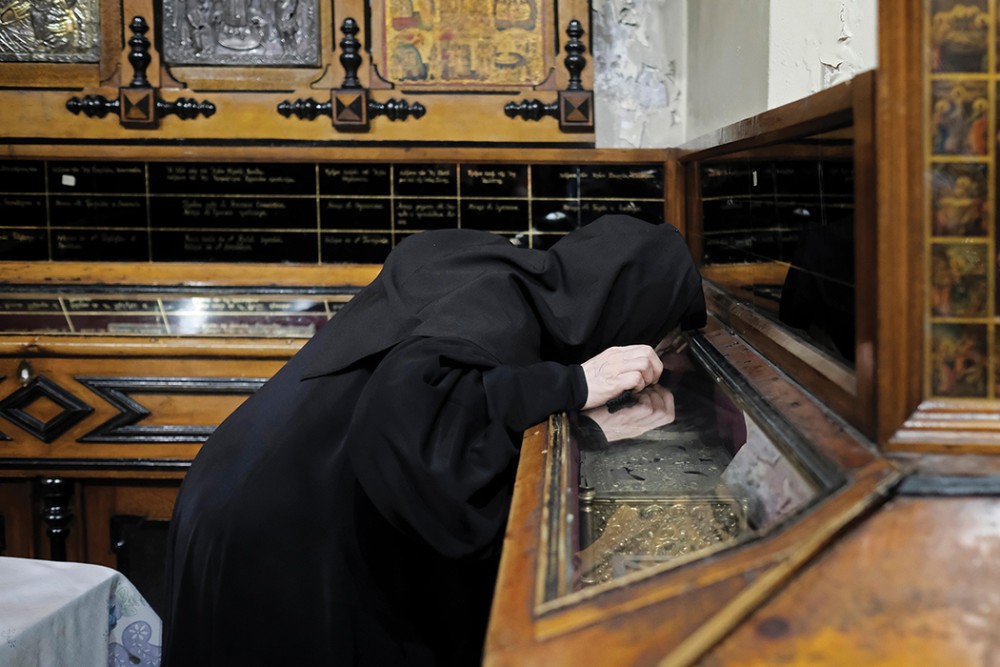The relics in Jerusalem didn’t move me. Why?
For some reason, I couldn’t find the holy in the holy rocks everyone else was venerating.

On my visit to Jerusalem I made an appointment to meet the Greek Orthodox patriarch at his office in the Church of the Holy Sepulchre. At the end of our meeting, he ushered me into a back room known as the Greek Treasury and left me alone, inviting me to “venerate the relics.” I was grateful that he left me alone, because I didn’t plan to venerate the relics.
Technically I knew how. I had spent enough time with Orthodox Christians and enough time in Jerusalem to know how to cross myself and bow in front of relics. I knew that one could kiss the glass or lean one’s forehead on the glass in a gesture of respect. But I couldn’t do these gestures with authenticity. Crossing myself and bowing felt imitative and hollow.
Read our latest issue or browse back issues.
The relics themselves were astonishing. There was a bone from John the Baptist and the hand of Mary Magdalene. There was a remnant of the True Cross. There were relics of John Chrysostom and the great liturgist St. Andrew of Crete. I stood in front of these relics like a visitor in a museum. I even smirked inwardly a little at the historical unlikelihood that these were actual relics. It was hard for this Protestant to figure out what to do, and that troubled me. Never had I felt so proximate to my fellow Christians and yet so distant from them.
At other moments in my weeks in Israel I struggled with a similar sense of otherness. I wasn’t just the “other” to the Jews and Muslims around me. I also felt other to other Christians. I was not drawn to the idea of seeing ancient biblical places. I couldn’t feel the magic of sensing that “it happened here in this place,” a feeling that draws many Christian pilgrims to Israel.
When I read the accounts of ancient pilgrims to the land, like Egeria, a fourth-century nun, or Melania, a fourth-century noblewoman, I do not find them inspiring but almost comical in their detail and attachment to specific places. “The bishop took us to the well where holy Jacob watered the animals of holy Rachel, which is six miles from Carrhae.” “Right at the head of the valley, where we had spent the night and seen the Burning Bush out of which God spoke to Moses, we saw also the place where Moses was standing before the Bush.” The burning bush? Someone thought they’d found it? How could one not be incredulous?
I don’t know if I am expressing a particularly Protestant smugness, but I know that I was left cold when the guide on the Via Dolorosa pointed out the impression that the elbow of Simon of Cyrene had made on a particular rock.
I was astonished to see the number of pilgrims from so many places in the world: Sri Lanka, Spain, Russia, Croatia, Poland, the Philippines. I was astonished too by the way they interacted with the sites. They seemed to have natural and ready-made gestures suited for the special places.
As I stood inside the edicule in the Church of the Holy Sepulchre, that holy of holies, I could feel that the place, my journey, and the moment all demanded a gesture on my part. Everyone around me seemed to know what to do. They bowed and crossed themselves. They wept. They sang. The woman in front of me had brought baby clothes, and she swept them across the rock in a practiced movement. I found myself jealous. All I knew how to do was stand and briefly gawk. I closed my eyes for a moment, but that was more a way of erasing the place and its strangeness than connecting to it. I felt closer to the tourists snapping selfies than to the Christians around me.
“It’s just a rock,” I told myself. “Everything else is imagination.” I didn’t say this dismissively. Imagination, as Einstein said, is more important than knowledge. Imagination is a critical part of faith. If I could enter into this collective imagination of the holy, perhaps I could grasp what was essential.
At the Church of the Nativity in Bethlehem I waited in a line with dozens of Russian pilgrims until we went down some stairs and entered a little cave where we stooped under a small opening. There was a rock that marked the place where Jesus was born. Or was it a rock that happened to be in the cave where Jesus was born? Or was it (as I had overheard one guide explaining) a rock that someone had told St. Helen was important in the Nativity story? I couldn’t keep track. I didn’t know what I was supposed to do in the presence of this rock or exactly why I had waited in line to see it. But the people around me touched it and crossed themselves and prayed over it.
Next to the rock stood a priest in a black robe collecting money in a basket. He was making change, and sometimes arguing with people about how much change he should give them. The presence of dollar bills surprised me. I recognized my own cultural bias in thinking that financial transactions that had to do with religion should be hidden or that the presence of money is tawdry. That’s obviously not how these people saw it.
I was also uncomfortable with thinking, “It’s just a rock.” I could see that an international community of Christians had chosen this place to remember the ancient stories. The combination of tradition and community made the rock more than a rock. But then, my internal argument continued, any individual Christian who has a particular kind of experience in relation to the rock needs some imagination. And my imagination was refusing to participate. I wondered why. I started to wonder if I truly was a Christian. I did not seem to have the right feeling for this religion.
A friend counseled me to get past the rocks and look at the people and at my fellow Christians. They were teaching me about my own faith. Sister Martha, a woman who ran a school for girls in al-Azariya (Bethany), told me that ours is an incarnational faith. We claim that God, in the form of Jesus, walked on the earth. These were the places that he touched. That kind of claim isn’t made, she said, in Islam or Judaism. The specificity of place had a special meaning for Christians.
Her coworker, Daniel, a Russian-German-Urgiz from Berlin, showed me a rock that had been discovered 60 years ago when the school had started to build a playground. In digging up the ground, they had found a rock with the words “I am the resurrection and the life” inscribed in Greek ancient enough to have been from the time of Jesus. Given the proximity of the rock to the tomb of Lazarus, they decided this was the place where Mary and Martha had rushed out to meet Jesus as he approached Bethany after the death of Lazarus. This was the place where Jesus had wept at the death of his friend. Maybe he had even sat down on this very rock to weep. The school had built a chapel over the rock. Daniel kindly invited me to venerate the rock.
Maybe, I thought, despite the rhetoric that I had so often used at home, my faith wasn’t incarnational at all. It certainly wasn’t incarnational in the way it was for my fellow pilgrims or for Daniel and Sister Martha.
When I met Archbishop Isidoros at the Church of the Holy Sepulchre, the church was more crowded than I had ever seen it. Delegations of people from all over the world paraded between me and the office of the Greek Orthodox Patriarchate. I made my way through the crowd and stepped through the door. The archbishop welcomed me warmly and asked me to sit down on a gold-covered couch. A monk brought me lemonade, and the archbishop directed me to the room with relics. After he left, I stood awkwardly until a group of Greek pilgrims came in. I watched them, then I bent my lips toward the True Cross and kissed the glass. I felt nothing but the aggravating feeling that I was faking it so that other people wouldn’t stare at me and know that I didn’t belong.
I escaped back to the couch. A Russian man popped his head in and said in English, “Where is it possible here to buy icons?” A monk who was looking at his phone on a chair opposite me gestured in a random direction and the man disappeared. A young woman in a tank top, with a wraparound skirt and ponytail, came in and said in bright American English, as if everyone would understand her immediately, “Is that rock out there a part of Jesus’ tomb?” The archbishop, who had just come back from an errand, pointed and said, “No, it’s around the other side.” She disappeared.
How many people, I wondered, come to the Church of the Holy Sepulchre and leave without ever knowing where the actual tomb is said to be? This is something that could easily have happened to me. “I went there. There was a big chunk of rock. That must’ve been it.” There were certainly no user-friendly interpretive signs. Most of those who do miss it must be Protestants, I thought.
I see now that I have a tendency to believe that if something is really true, close to ultimate reality, then it’s not something you can look at. I was the child of a mostly abstract faith. I had been given some theological concepts and taught to marry them to biblical texts and ethical deeds. The sum total of this, with the addition of mostly silent and inward prayer, was what I called faith. This or that holy rock hadn’t come into it. And there was no room at all for the veneration of relics.
I was taught as a child that needing to see something to believe it was true was almost a kind of sin. “Blessed are those who have not seen and yet have come to believe,” our Sunday school teachers emphasized, mindful of Jesus’ words to Thomas (John 20:29). This probably wasn’t intended to be a rejection of the visible world, but somehow I had come to interpret it that way.
In Jerusalem, people said to me over and over again, “This is where ultimate reality laid his head. This is where ultimate reality rose from the dead. This is the rock of ultimate reality.” My response had been to shrug and think, it can’t possibly be ultimate reality, because ultimate reality cannot be seen with ordinary eyes.
In Jerusalem, I realized that my version of the incarnational faith may be incarnation lite—more a principle than an intimate way of relating to the physical world. I was repeatedly invited to see and respond to the physical world in ways I couldn’t quite manage. I could only go through the motions.
I felt cut off from common devotional experience and from a natural connection to other Christians—apparently, most other Christians in the world. All I could do was add my own prayer, silent and inward as it may have been, an almost agnostic prayer, in that place which has been collecting the prayers of pilgrims for thousands of years.
A version of this article appears in the print edition under the title “Going through the motions.”






